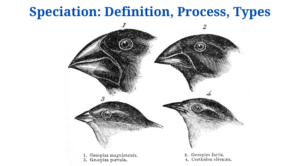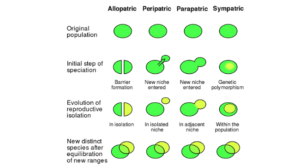Definition of Specification
Speciation is the process of evolution which results in the emergence of a new genetically independent group of creatures known as a species.
- Speciation is the process of dividing a genetically homogeneous population into two or more populations, each of which undergoes genetic differentiation as well as eventually reproductive isolation.
- The creation of new populations (species) with better adaptability than their ancestors determines the trajectory of evolution.
Speciation can take place in two ways.
- Over time, old species are transformed into new ones.
- Multiplication of species is the division of a single species into numerous.
Image Source: Wikipedia (Ilmari Karonen)
Causes of Speciation
Speciation is caused by a number of factors, including:
1 . Natural selection
- Different individuals in a species may have particular distinct qualities that are favourable as well as alter the genetic composition of the person, as outlined by Charles Darwin.
- These features will be retained under these settings, as well as new species may emerge over time.
- However, the most important element of this component in this circumstance is that speciation happens only when a single species divides into multiple species, resulting in species multiplication.
2. Genetic Drift
- Genetic drift is the shift in allele frequencies in a population caused by “sampling error” while choosing alleles for the following generation from the current population’s gene pool.
- However, it has been suggested that genetic drift does not lead to speciation, but rather to evolution, or change from one species to another, which is not the same as speciation.
3. Migration
- When a population of species migrates from one geographical region to another, the species may develop features that are distinct from those of the original population.
- In most cases, migration results in geographical isolation, which leads to speciation.
4. Mutations in the Chromosome
- Chromosomal mutations have the ability to act as (or contribute to) isolating mechanisms, as well as the locking up as well asprotection of a highly advantageous gene complement.
- These mutations, if passed down from generation to generation, could lead to the emergence of new species.
5. Natural causes
- Natural events imposed by the environment, such as a river or a mountain range, can sometimes result in the division of what was once a single community into two or smaller communities.
- These events cause the incipient species to become geographically isolated, followed by reproductive isolation, which leads to speciation.
6. Gene flow reduction
- In the absence of some extrinsic physical obstacles, speciation may occur.
- There could be a reduction in gene flow across a vast geographical area, with individuals in the far east having no possibility of mating with those in the far west.
- Furthermore, if some selecting mechanisms such as genetic drift exist at different ends of the spectrum, gene frequencies will be altered, ensuring speciation.
Process of speciation (how does speciation happen?)
Speciation has traditionally been thought to be a three-stage process:
- Population isolation is a term used to describe the process of isolating people.
- Separated populations’ trait divergence (e.g. mating system or habitat use).
- Reproductive isolation of populations which keeps them apart when they come into contact again (secondary contact).
- According to recent study, steps one as well as two can occur in the same location at the same time, while the third step is frequently skipped.
- The process of speciation begins with the isolation of a subpopulation of a species, which can occur either physically (allotropic speciation) or genetically (genetically isolated subpopulations) (sympatric speciation).
- Once the population has been divided, minor genetic variations accumulate over time, resulting in a subpopulation of a species which eventually accumulates enough differences to become another species.
- The subpopulation is now genetically independent as well as will continue to diverge due to mutation, selection, as well as genetic drift over time.
- Genetic divergence may result in a minor alteration in the mating dance or even a minor variation in the morphology of the male genitalia, as well as changes in the subpopulation‘s environment or dietary preferences, resulting in reproductive isolation.
- Even if the modes of separation were abolished, the genetic divergence between the subpopulations would eventually grow so high that the production of hybrids between them would be medically, developmentally, or behaviorally impossible.
Speciation Modes/Types of Speciation
The mechanisms or forms of speciation are classified according to how much geographical separation of the original population contributes to reduced gene flow as well as , eventually, the development of new species.
The following are the modes of speciation:
Comparison of Allopatric, Peripatric, Parapatric and Sympatric speciation Image Source: Wikipedia (Ilmari Karonen)
1 . Allopatric Speciation (What is allopatric speciation?)
- The process of speciation in which the original population is divided into two by a barrier, resulting in reproductive isolation, is known as allopatric speciation.
- Mayr presented his model for allopatric speciation.
- It is predicated on the idea that when a physical geographic barrier divides a species’ big population into two or more tiny populations, new species emerge.
- Because of their physical isolation, these isolated groups are unable to interbreed.
- Physical isolation can be caused by physical obstacles such as extensive ocean stretches, high mountains, glaciers, deep river valleys, wide rivers, or deserts, or by a significant distance due to a larger geographical range.
- Each isolated population begins to adapt to its own environment, collecting distinctions as well asevolving into new species on its own.
- Even when the barrier allows some individuals to cross the barrier to mate with members of the other groups, allopatric speciation can occur.
- Gene flow between the soon-to-be species must be greatly decreased, but not completely eliminated, for speciation to be deemed “allopatric.”
Allopatric speciation examples
- Darwin’s finches are a typical example of allopatric speciation. Finches from different populations in the Galapagos Islands were found to have variances in body size, colour, as well as beak length or shape.
- The variances arose as a result of the varying types of food accessible on each island.
- Another example is the Grand Canyon Squirrels, which split into two species during the construction of the Grand Canyon.
2. Pepripatric Speciation
- Peripatric speciation is a type of allopatric speciation which takes place when the isolated group is quite tiny.
- In this scenario, genetic drift is relevant in addition to geographic separation, because genetic drift occurs more quickly in small populations.
- The small isolated subpopulation may carry some unusual genes which become fixed over the course of a few generations as a result of genetic drift once they reach the new geographical location.
- As a result, these unusual genes are found throughout the whole population of the new region.
- New genetic features, and natural selection, result in the survival of individuals who are better adapted to the new region’s environment as well asfood.
- Finally, new species emerge as a result of the interaction of all of these variables.
- However, explaining the role of genetic drift in the divergence of the two populations is complex, making accumulating evidence to support or disprove this approach problematic.
Peripatric Speciation Examples
Petripatric speciation can be shown in the Australian bird Petroica multicolor as well asthe London Underground mosquito, a form of the mosquito Culex pipiens which first appeared in the London Underground in the 19th century.
3. Parapatric Speciation
- Parapatric speciation is a mode of speciation wherein there is no external barrier between populations, but the population’s vast geographic range drives individuals to mate with neighbours rather than with people from other parts of the range.
- The population is continuous in this example, but it does not mate at random.
- Reduced gene flow within the population as well as varied selection pressures over the population’s distribution cause genetic heterogeneity in this population.
- This happens when a population is dispersed across a vast geographic area. As a result, individuals in the far west region are not able to mate with those in the far east region.
- Within the existing population, new species could emerge after a few generations.
Parapatric speciation examples
- Some species of the grass Anthoxanthum odoratum which dwell near mines have become tolerant to heavy metals; however, other plants which do not reside near mines are not.
- However, since plants are so close together, they may fertilise one another, resulting in the emergence of a new species.
4. Sympatric Speciation (What is sympatric speciation?)
- The development of new species from an original population which is not geographically isolated is known as sympatric speciation.
- It depends on the development of new populations of a species in distinct ecological niches, as well as the reproductive isolation of the new population’s founders from the individuals of the parent population.
- Intrinsic variables like as chromosomal alterations as well as non-random mating are thought to hinder gene flow between the daughter as well as parental populations during sympatric speciation.
- Individuals using a new niche may diminish gene flow with individuals exploiting a different niche.
- This mechanism of speciation occurs frequently in herbivore insects when they start feeding as well as mating on a new plant or when a new plant is introduced within the species’ geographical range.
- The gene flow between species that specialise in a particular plant is then restricted, potentially leading to the emergence of new species.
- For the population to diverge, the selection resulting in specialisation must be extremely strong.
- In multicellular creatures or randomly mated populations, sympatric speciation is thus a spontaneous process.
Sympatric Speciation Examples
- Sympatric speciation has been documented in apple maggot flies, which laid eggs and bred only on hawthorns 200 years ago but today lays eggs on both hawthorns as well as domestic apples.
- Consequently, gene flow among segments of the population which mate on various kinds of fruit is limited, and certain genetic variations among these two groups of flies have evolved in less than 200 years.
Speciation Citation
- Verma PS and Agarwal VK (3005). Cell Biology, Genetics, Molecular Biology, Evolution, and Ecology. Multicolored Edition.
- Griffiths AJF, Miller JH, Suzuki DT, et al. An Introduction to Genetic Analysis. 7th edition. New York: W. H. Freeman; 2000. Process of speciation.Available from: https://www.ncbi.nlm.nih.gov/books/NBK22000/
- https://biologydictionary.net/speciation/
- https://evolution.berkeley.edu/evo101/VC1bAllopatric.shtml
- https://coolaustralia.org/wp-content/uploads/2015/02/Speciation-factsheet.pdf
- https://www.biologyonline.com/dictionary/peripatric-speciation
- https://quizlet.com/22652175/ch-25-genetics-possible-questions-flash-cards/
- https://evolution.berkeley.edu/evolibrary/article/_0/speciationmodes_02
Related Posts
- Phylum Porifera: Classification, Characteristics, Examples
- Dissecting Microscope (Stereo Microscope) Definition, Principle, Uses, Parts
- Epithelial Tissue Vs Connective Tissue: Definition, 16+ Differences, Examples
- 29+ Differences Between Arteries and Veins
- 31+ Differences Between DNA and RNA (DNA vs RNA)
- Eukaryotic Cells: Definition, Parts, Structure, Examples
- Centrifugal Force: Definition, Principle, Formula, Examples
- Asexual Vs Sexual Reproduction: Overview, 18+ Differences, Examples
- Glandular Epithelium: Location, Structure, Functions, Examples
- 25+ Differences between Invertebrates and Vertebrates
- Lineweaver–Burk Plot
- Cilia and Flagella: Definition, Structure, Functions and Diagram
- P-value: Definition, Formula, Table and Calculation
- Nucleosome Model of Chromosome
- Northern Blot: Overview, Principle, Procedure and Results



















1 thought on “Speciation: Definition, Process, Types and Examples”